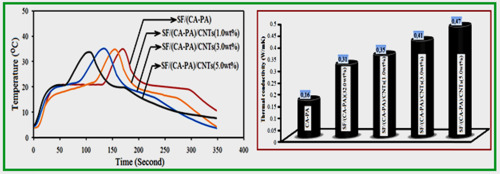当前位置:
X-MOL 学术
›
Sol. Energy Mater. Sol. Cells
›
论文详情
Our official English website, www.x-mol.net, welcomes your feedback! (Note: you will need to create a separate account there.)
Silica fume/capric acid-palmitic acid composite phase change material doped with CNTs for thermal energy storage
Solar Energy Materials and Solar Cells ( IF 6.9 ) Pub Date : 2018-06-01 , DOI: 10.1016/j.solmat.2017.12.036 Ahmet Sarı , Alper Bicer , Amir Al-Ahmed , Fahad A. Al-Sulaiman , Md. Hasan Zahir , Shamseldin A. Mohamed
Solar Energy Materials and Solar Cells ( IF 6.9 ) Pub Date : 2018-06-01 , DOI: 10.1016/j.solmat.2017.12.036 Ahmet Sarı , Alper Bicer , Amir Al-Ahmed , Fahad A. Al-Sulaiman , Md. Hasan Zahir , Shamseldin A. Mohamed

|
Abstract Though very promising, fatty acids suffer from low thermal conductivity and leakage, which limits their heat storage applications. To overcome these problems, we used silica fume (SF) to house the fatty acid and prevent leaching during phase change and incorporated different amount (1.0, 3.0 and 5.0 wt%) of CNTs to improve the thermal conductivity to the desired level. For the experimental temperature range and better performance an eutectic mixture of capric acid(CA)-palmitic acid(PA) was prepared and investigated. The physicochemical and morphological characterizations of the fabricated shape stabilized-composite PCMs (SS-CPCMs) with/without CNTs were carried out using FTIR, XRD and SEM instruments. The DSC analysis results showed the SS-CPCMs had phase change temperatures of 19–26 °C and high latent heat capacity of 46–49 J/g, which are suitable for thermal energy storage (TES) in buildings. The SS-CPCMs showed good cycling TES reliability and chemical stability and also exhibited excellent thermal durability up to 140 °C. The CNTs doping process caused an appreciable increase in thermal conductivity and significantly reduced the charging and discharging times of the SS-CPCMs. Consequently, due to higher thermal conductivity, the SS-CPCM doped with 5.0 wt% CNTs can be considered as more promising composite for passive solar thermoregulation of building envelopes.
中文翻译:

碳纳米管掺杂硅粉/癸酸-棕榈酸复合相变材料用于热能存储
摘要 脂肪酸虽然非常有前景,但其导热性和泄漏率低,限制了其储热应用。为了克服这些问题,我们使用硅粉 (SF) 来容纳脂肪酸并防止相变过程中的浸出,并掺入不同量(1.0、3.0 和 5.0 wt%)的 CNT 以将热导率提高到所需的水平。为了实验温度范围和更好的性能,制备并研究了癸酸(CA)-棕榈酸(PA)的低共熔混合物。使用 FTIR、XRD 和 SEM 仪器对具有/不具有 CNT 的制造的形状稳定复合 PCM(SS-CPCM)的物理化学和形态特征进行了表征。DSC 分析结果表明 SS-CPCMs 的相变温度为 19-26 °C,潜热容量为 46-49 J/g,适用于建筑物中的热能储存 (TES)。SS-CPCM 显示出良好的循环 TES 可靠性和化学稳定性,并且在高达 140°C 时也表现出出色的热耐久性。CNTs 掺杂过程导致热导率显着增加,并显着减少了 SS-CPCMs 的充电和放电时间。因此,由于具有更高的热导率,掺杂 5.0 wt% CNTs 的 SS-CPCM 可以被认为是更有前途的复合材料,用于建筑围护结构的被动太阳能温度调节。CNTs 掺杂过程导致热导率显着增加,并显着减少了 SS-CPCMs 的充电和放电时间。因此,由于具有更高的热导率,掺杂 5.0 wt% CNTs 的 SS-CPCM 可以被认为是更有前途的复合材料,用于建筑围护结构的被动太阳能温度调节。CNTs 掺杂过程导致热导率显着增加,并显着减少了 SS-CPCMs 的充电和放电时间。因此,由于具有更高的热导率,掺杂 5.0 wt% CNTs 的 SS-CPCM 可以被认为是更有前途的复合材料,用于建筑围护结构的被动太阳能温度调节。
更新日期:2018-06-01
中文翻译:

碳纳米管掺杂硅粉/癸酸-棕榈酸复合相变材料用于热能存储
摘要 脂肪酸虽然非常有前景,但其导热性和泄漏率低,限制了其储热应用。为了克服这些问题,我们使用硅粉 (SF) 来容纳脂肪酸并防止相变过程中的浸出,并掺入不同量(1.0、3.0 和 5.0 wt%)的 CNT 以将热导率提高到所需的水平。为了实验温度范围和更好的性能,制备并研究了癸酸(CA)-棕榈酸(PA)的低共熔混合物。使用 FTIR、XRD 和 SEM 仪器对具有/不具有 CNT 的制造的形状稳定复合 PCM(SS-CPCM)的物理化学和形态特征进行了表征。DSC 分析结果表明 SS-CPCMs 的相变温度为 19-26 °C,潜热容量为 46-49 J/g,适用于建筑物中的热能储存 (TES)。SS-CPCM 显示出良好的循环 TES 可靠性和化学稳定性,并且在高达 140°C 时也表现出出色的热耐久性。CNTs 掺杂过程导致热导率显着增加,并显着减少了 SS-CPCMs 的充电和放电时间。因此,由于具有更高的热导率,掺杂 5.0 wt% CNTs 的 SS-CPCM 可以被认为是更有前途的复合材料,用于建筑围护结构的被动太阳能温度调节。CNTs 掺杂过程导致热导率显着增加,并显着减少了 SS-CPCMs 的充电和放电时间。因此,由于具有更高的热导率,掺杂 5.0 wt% CNTs 的 SS-CPCM 可以被认为是更有前途的复合材料,用于建筑围护结构的被动太阳能温度调节。CNTs 掺杂过程导致热导率显着增加,并显着减少了 SS-CPCMs 的充电和放电时间。因此,由于具有更高的热导率,掺杂 5.0 wt% CNTs 的 SS-CPCM 可以被认为是更有前途的复合材料,用于建筑围护结构的被动太阳能温度调节。



























 京公网安备 11010802027423号
京公网安备 11010802027423号